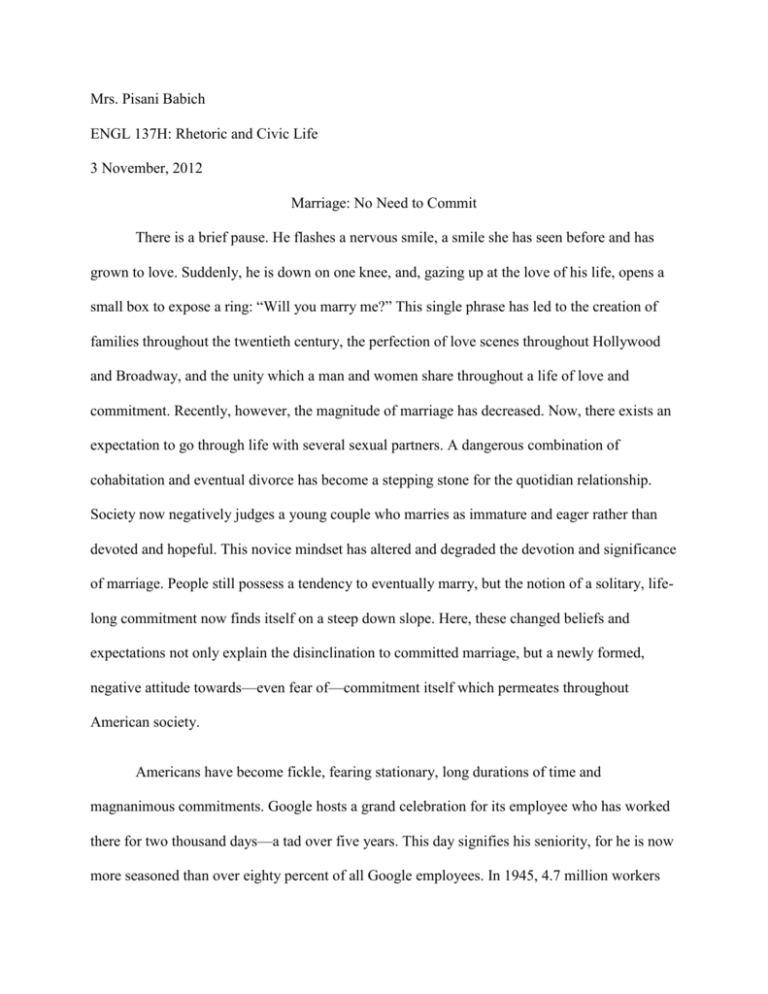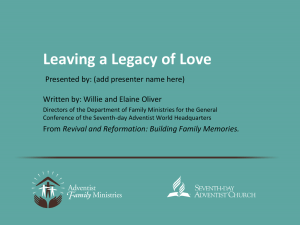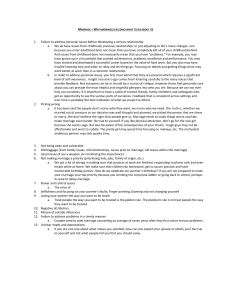
Mrs. Pisani Babich
ENGL 137H: Rhetoric and Civic Life
3 November, 2012
Marriage: No Need to Commit
There is a brief pause. He flashes a nervous smile, a smile she has seen before and has
grown to love. Suddenly, he is down on one knee, and, gazing up at the love of his life, opens a
small box to expose a ring: “Will you marry me?” This single phrase has led to the creation of
families throughout the twentieth century, the perfection of love scenes throughout Hollywood
and Broadway, and the unity which a man and women share throughout a life of love and
commitment. Recently, however, the magnitude of marriage has decreased. Now, there exists an
expectation to go through life with several sexual partners. A dangerous combination of
cohabitation and eventual divorce has become a stepping stone for the quotidian relationship.
Society now negatively judges a young couple who marries as immature and eager rather than
devoted and hopeful. This novice mindset has altered and degraded the devotion and significance
of marriage. People still possess a tendency to eventually marry, but the notion of a solitary, lifelong commitment now finds itself on a steep down slope. Here, these changed beliefs and
expectations not only explain the disinclination to committed marriage, but a newly formed,
negative attitude towards—even fear of—commitment itself which permeates throughout
American society.
Americans have become fickle, fearing stationary, long durations of time and
magnanimous commitments. Google hosts a grand celebration for its employee who has worked
there for two thousand days—a tad over five years. This day signifies his seniority, for he is now
more seasoned than over eighty percent of all Google employees. In 1945, 4.7 million workers
belonged to a union (Unions). Today, a young male finally receives a job offer and abandons the
ranks of unemployment, but continues his job search the next day (Workers). The average
consumer will not—cannot— possess the same iPhone for more than six months. People now
lease cars due to preference rather than economic planning. The average citizen is no longer
“married” to any aspect or decision of life.
This lack of—fear of—commitment manifests itself in the culture of marriage. Whether it
consists of a father collecting pay for his daughter, the passionate love associated with the
Romantic Era, or a simple couple with aspirations to start a family, historian Will Durant’s
words remain valid: “marriage is older than man” (Shaffer). Marriage was once “based on
economic viability, child rearing and a sense that this is something that all adults should do”
explains William Doherty, director of the Marriage and Family Therapy Program at the
University of Minnesota in St. Paul (Masci). Along with rational necessities, marriage also
consisted of the irrational: love. The 1950’s hit song Love and Marriage declared that the two
went together “like a horse and carriage” (Are Americans). This was completely true in the
1950s—a loving, united couple of husband and wife headed practically every household in the
fifties (Are Americans). Businesswoman Melissa Jurgens offers a more modern example that
epitomizes the love and commitment that defines a traditional marriage:
After I married Jim, I had someone I could talk to all the time and who could
support me in ways that my friends, as wonderful as they are, just can’t. He’s
more than a friend: He’s committed to me, like I am to him, and that makes all the
difference. We’re going to be living together for the next 50 years, and so he
needs to ensure that I’m OK and happy (Masci).
In the early and mid nineteenth century, people emulated Melissa. They fell in love with
someone, married that special person and remained with him or her for the rest of their lives.
In the 1960’s and 1970’s, marriage was certainly still quite common, but the notion of
sex as an act of pleasure came to the forefront during these two decades. The car became a
means not just for transportation, but for sexual pleasure as well. Around this time period over
fifty percent of women had engaged in premarital coitus (Shaffer). Fortunately, the idea of
commitment did not completely vanish from the minds of youth in this decade. For example, in
the early sixties, a non-virginal bride had only had sex with one man before marrying: her future
husband. Later in that same decade, however, a 1968 survey illustrated that only nineteen percent
of women engaged in sex for the first time while they were engaged, while an overwhelming
three-fourths of women first experienced this while in a simple dating relationship (Shaffer). In
1970, fifty five percent of college students stated that “virginity was not an important
characteristic of their future spouse” (Shaffer). Thus, by the late 1960s and 1970s, America was
well on its way to not overlooking marriage all together, but downplaying the importance of the
commitment which accompanied marriage. By this time, having several sexual partners was
considered impressive, and loyalty to one love was becoming dated. This movement implied that
exclusivity—a major part of commitment—no longer possessed a place in the institution of
marriage. Here, the youth of America suggested that they would rather experience a variety of
pleasure rather than sacrificing—another important aspect of commitment—by practicing
patience and eventually physically dedicating themselves to one partner.
Today, commitment in regards to sexual interaction is minimal. Mate Swapping or
“Swinging” has become a commonplace amongst most middle class families—a rough estimate
of between one million and eight million couples have experienced this new movement (Shafer).
The sense of devotion between a man and wife must diminish when both have already engaged
in coitus throughout each spouse’s coterie of close friends. At times this swapping may occur
simply by coincidence—two people may engage each other physically years before one marries
the partner’s friend. There are instances, however, where two couples will enjoy a meal and
agree to exchange mates for the night (Shafer). Here, this demonstrates that the physical bond
they experience as a married couple carries little to zero significance. Just as premarital sex with
several partners degrades the significance of exclusivity, this act of swapping diminishes the
sense of duty and solidarity portrayed through marriage, thus further tarnishing the idea of
commitment.
He is down on one knee, and, gazing up at his girlfriend, opens his hand to expose a key:
“Will you move in with me?” While the sense of commitment in marriage has diminished due to
an increase in eclectic sexual activity, it has also suffered from an upsurge of cohabitation and
eventual divorce. Society once frowned upon cohabitation, declaring the act to be a lack of
patience. Now it accepts the decision as a common and even necessary precursor to marriage.
Cohabitators view themselves as liberal, experimenting and androgynous—paralleling the
attitudes of the expanding sex culture (Newcomb). In just six years, the number of cohabiting
couples increased by 1.5 million (Masci). People are now marrying later, postponing what they
view to be a scary leap. Dimitra Hengen, a middle-aged business woman, epitomizes the lack of
motivation and hidden fear associated with taking this leap:
I have a wonderful boyfriend right now, and he wants to marry me, but I
don't even want to live with him. I want to be able to come and go as I
please, to travel, to see friends and family, all without the compromises
that come with marriage. I don't need marriage (Masci).
Most people are unlike Dimitra and engage in cohabitation anticipating marriage, simply hoping
to become better acquainted with the person on a daily basis. Studies delineate, however, that
couples who cohabitate are more prone to divorce (Edmonds). Why would cohabitating not lead
couples to make more mature marital decisions? “The course of true love never did run smooth,”
Shakespeare once said (Edmonds). Cohabitation neglects to present a young couple with the
reality of marriage. Once married, this same couple may experience less pressure to please each
other, and one or both parties will feel violated or wronged. For this reason, about forty three
percent of current couples will divorce within one year of marrying (Edmonds). They realize
they are not ready to commit regardless of the circumstances. Like rampant sex, this deadly
combination has evolved from an abnormality into a commonplace. In the past fifty years,
divorce rates of American couples have increased by nearly one hundred percent, rising from
one-fourth to nearly one-half (Masci). Although these couples did eventually choose marriage,
they too add to the degradation of marital commitment. These marriages lacked a real sense of
devotion. Cohabitation and especially divorce caused these couples to declare that their marriage,
their covenant, was null and void all along.
Marriage still exists, but much has changed since the 1950’s. Love and marriage may still
“go together like a horse and carriage,” but constant premarital sex, “swinging,” and a
combination of cohabitation and divorce may also accompany this once holy act of commitment
(Are Americans). Considering these new themes, it is quite evident that the average American
citizen regards the sense of commitment associated with marriage as minimal, trivial or even
non-existent. This lack of commitment does not remain isolated in marriage, as it permeates
throughout modern American society. The question “will you marry me?” always melts the
heart, but the question “will you commit?” challenges it.
Are Americans still in love with marriage? (1990). Editorial research reports 1990. Washington,
DC: CQ Press. Retrieved from
http://library.cqpress.com/cqresearcher/cqresrre1990070600
Edmonds, Molly. "Does Living Together before Marriage Lead to Divorce?" Discovery Health.
N.p., n.d. Web. 23 Oct. 2012.
<http://health.howstuffworks.com/relationships/advice/living-together-beforemarriage.htm>.
Masci, D. (2004, May 7). Future of marriage. CQ Researcher, 14, 397-420. Retrieved from
http://library.cqpress.com/cqresearcher/
Newcomb, Michael D. and Peter M. Bentler. “Cohabitation before marriage: A comparison of
married couples who did and did not cohabitate.” Journal of Family and Economic Issues
3.1 (1980): 65-85. Print.
Shaffer, H. B. (1971). Marriage: changing institution. Editorial research reports 1971 (Vol. II).
Washington, DC: CQ Press. Retrieved from
http://library.cqpress.com/cqresearcher/cqresrre1971100600
"Unions: The Heyday of Organized Labor." American Decades. Ed. Judith S. Baughman, et al.
Vol. 5: 1940-1949. Detroit: Gale, 2001. Gale Virtual Reference Library. Web. 23 Oct.
2012.
"Workers." American Decades. Ed. Judith S. Baughman, et al. Vol. 10: 1990-1999. Detroit:
Gale, 2001. Gale Virtual Reference Library. Web. 23 Oct. 2012.








